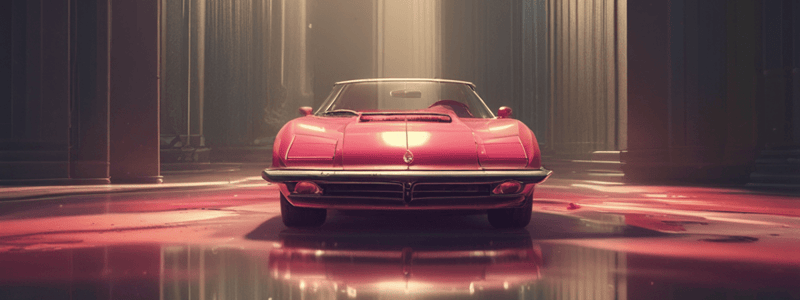Podcast
Questions and Answers
Which of the following is NOT a property of light?
Which of the following is NOT a property of light?
- Wavelength
- Frequency
- Speed
- Mass (correct)
What is the speed of light in a vacuum?
What is the speed of light in a vacuum?
- 299,792 miles per hour
- 299,792 kilometers per second (correct)
- 299,792 miles per second
- 299,792 meters per second
Which of the following is an example of a natural light source?
Which of the following is an example of a natural light source?
- Incandescent bulb
- LED lamp
- Fluorescent light
- Fireflies (correct)
Light exhibits both wave and particle properties due to which phenomenon?
Light exhibits both wave and particle properties due to which phenomenon?
Which of the following is NOT a property of light that varies depending on the medium?
Which of the following is NOT a property of light that varies depending on the medium?
What is the term used to describe the oscillation of light waves perpendicular to their direction of motion?
What is the term used to describe the oscillation of light waves perpendicular to their direction of motion?
Which of the following is an example of an artificial light source?
Which of the following is an example of an artificial light source?
What is the term used to describe the bending of light as it passes from one medium to another?
What is the term used to describe the bending of light as it passes from one medium to another?
Which of the following describes the behavior of light when it encounters an opaque object?
Which of the following describes the behavior of light when it encounters an opaque object?
What is the term used to describe the spreading out of light waves as they pass through an opening or around an obstacle?
What is the term used to describe the spreading out of light waves as they pass through an opening or around an obstacle?
What is the primary cause of shadows?
What is the primary cause of shadows?
Which factor influences the shape and size of shadows?
Which factor influences the shape and size of shadows?
What happens when light is absorbed by electrons associated with a material's atoms?
What happens when light is absorbed by electrons associated with a material's atoms?
In what way do diffuse reflections differ from specular reflections?
In what way do diffuse reflections differ from specular reflections?
What type of surface can result in specular reflections?
What type of surface can result in specular reflections?
What is the main reason why the side of an object away from a light source appears darkened?
What is the main reason why the side of an object away from a light source appears darkened?
How do shadows form according to the text?
How do shadows form according to the text?
Flashcards are hidden until you start studying
Study Notes
Light plays a crucial role in our daily lives, from providing illumination to facilitating vision and communication. Understanding its properties, how it interacts with various surfaces, and how shadows form is essential for appreciating the complexities involved in the study of light dynamics. Here we explore the basic concepts surrounding light and shadow phenomena.
Properties of Light
Light is a form of electromagnetic radiation, which propagates through space in waves. These waves oscillate perpendicular to their direction of motion, exhibiting both electric and magnetic components. Light displays wave properties such as interference, diffraction, and refraction, but also behaves like particles called photons under certain conditions due to the photoelectric effect. Light has several key properties, including speed, wavelength, frequency, energy, and intensity. Its speed in vacuum (approximately 299,792 kilometers per second) is considered constant, while these other parameters vary depending on the medium through which the light travels.
Light Sources
Various natural and artificial processes generate light sources. The sun, stars, fireflies, glowworms, and bioluminescent organisms emit light naturally, relying on chemical reactions or energy conversion within biological structures. Artificial light sources can come from incandescent bulbs, fluorescent lights, LED lamps, lasers, and even digital screens. Each source emits light across different parts of the visible spectrum, affecting color perception and brightness.
Shadows Formation
Shadows result from the blocking of light by objects or obstacles. When light passes through an opening, it illuminates everything on the side where the object's outline is cast against the background behind the object. The side of the object away from this light source appears darkened because no direct light reaches that area. This creates the perception of a shadow. Shadows can vary in shape and size depending on the relative sizes of the objects casting them and their position with respect to the light source.
Reflection of Light
Reflections occur when light is scattered in different directions after colliding with a surface, such as a smooth metal table or a textured wall. Depending on the angle of incidence between the incoming light ray and the reflective surface, reflections can result in various visual effects. For instance, parallel light incident upon a flat mirror forms a reflection with the same orientation but opposite direction. Specular reflections exhibit high luminosity and clarity, while diffuse reflections are more spread out with lower brightness.
Absorption of Light
When light interacts with materials, some portion of its energy may get absorbed rather than reflected. This occurs when light is absorbed by electrons associated with the material's atoms, causing them to jump to higher-energy states. The absorbed energy can be released in the form of heat, photons, or other forms of energy, depending on the material's properties and the conditions under which absorption takes place.
In summary, light and shadows are fundamental aspects of our environment, and understanding their properties, interactions, and effects is crucial for various applications, from scientific research to engineering design and daily life.
Studying That Suits You
Use AI to generate personalized quizzes and flashcards to suit your learning preferences.




